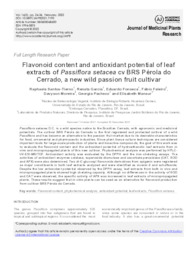Flavonoid content and antioxidant potential of leaf extracts of Passiflora setacea cv BRS Pérola do Cerrado, a new wild passion fruit cultivar.
Flavonoid content and antioxidant potential of leaf extracts of Passiflora setacea cv BRS Pérola do Cerrado, a new wild passion fruit cultivar.
Author(s): SANTOS-TIERNO, R.; GARCIA, R.; FONSECA, E.; FALEIRO, F. G.; MOREIRA, D.; PACHECO, G.; MANSUR, E.
Summary: Passiflora setacea D.C. is a wild species native to the Brazilian Cerrado, with agronomic and medicinal potentials. The cultivar BRS Pérola do Cerrado is the first registered and protected cultivar of a wild Passiflora and has become an alternative to the passion fruit market due to its desirable characteristics for food, ornamental and pharmaceutic industries. Since plant tissue culture techniques are considered important tools for large-scale production of plants and bioactive compounds, the goal of this work was to evaluate the flavonoid content and the antioxidant potential of hydroethanolic leaf extracts from in vivo and micropropagated plants of this new cultivar. Phytochemical analysis was performed by HPLCUV-ESI-MS/TOF. Antioxidant activity was evaluated by the DPPH and the iron-chelating assays. The activities of antioxidant enzymes catalase, superoxide dismutase and ascorbate peroxidase (CAT, SOD and APX) were also determined. Two di-C-glucosyl flavonoids derivatives from apigenin were registered as major constituents in both leaf extracts analyzed and were identified as vicenin-2 and schaftoside. Despite the low antioxidant potential observed by the DPPH assay, leaf extracts from both in vivo and micropropagated plants showed high chelating capacity. Although no differences in the activity of SOD and CAT were observed, the specific activity of APX was increased in leaf extracts of micropropagated plants. These results suggest that in vitro plants can be used as an alternative for flavonoid production from cultivar BRS Pérola do Cerrado.
Publication year: 2022
Types of publication: Journal article
Unit: Embrapa Cerrados
Observation
Some of Embrapa's publications are published as ePub files. To read them, use or download one of the following free software options to your computer or mobile device. Android: Google Play Books; IOS: iBooks; Windows and Linux: Calibre.
Access other publications
Access the Agricultural Research Database (BDPA) to consult Embrapa's full library collection and records.
Visit Embrapa Bookstore to purchase books and other publications sold by Embrapa.

